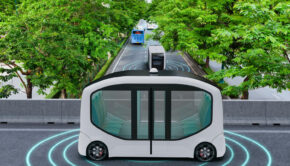Smart Car Technology and the Internet of Things
Sam switches on his indicator to signal that he’s about to change lanes and overtake the car in front of us. Much to my surprise, the display screen on his Honda Accord’s dashboard switches from the music app to show a live camera stream of his car’s blind spots.
All clear! We make a safe and seamless lane change. The display screen returns to show the music app and a summary of the local time, temperature, and 5 day forecast.
That was the first time that I had a real glimpse into what is now commonly referred to as smart car technology. As I sat there in the passenger seat, I couldn’t help but remember one of my favourite childhood TV shows Knight Rider, starring David Hasselhoff as Michael Knight. Knight’s faithful sidekick KITT, a 1982 Pontiac Trans Am was as much the star of the show as the Hoff himself. At least once every episode, KITT would kick into autopilot mode, allowing Michael to focus on more important matters like fighting off bad guys while hanging out the window.
The car was an artificially intelligent electronic computer module in the body of a very advanced automobile. KITT boasted several futuristic special features like turbo boost, the ability to drive himself and micro scanners, which allowed him to see and respond to things around him. To top it all off, his microprocessor allowed him to think, learn, and communicate with humans.
Back in the 80’s some critics may have dismissed the show for being too over the top and unrealistic. Little did they know that virtually all of KITT’s special features can now be found in some form in newer cars.
The Internet of Things
Imagine a world with better machine-to-machine and object-to-object communication. Picture that virtually everything is wirelessly connected and sharing information to make your daily life more efficient and tailored to your preferences.
Well there’s no need to image, the internet of things is here. The IoT (Internet of Things) is a network of devices, buildings, machines and vehicles, equipped with sensors, software, electronics and network connectivity that allows these things to collect, share, analyze and exchange data.
One of the most important markets for the IoT is the automotive industry. Developing connected smart cars is about more than creating cars that drive themselves and avoid accidents. Smart cars are creating new opportunities to reduce traffic and improve overall transportation efficiency.
Connectivity amongst vehicles will not only allow the exchange of data among road users, but also with the infrastructure of roads and buildings. Resulting in safer and more efficient traffic systems.
In the US, the average driver spends 38 hours per year stuck in traffic. With an expected rise in the number of inhabitants in big cities, traffic congestion can only get worse. Creating a secure, competent and enjoyable driving experience will be absolutely necessary.
Safety First
According to the World Health Organization, it is estimated that there are about 1.2 million road traffic deaths worldwide every year.
One of the most obvious benefits of improving smart car technology is that it will help to decrease traffic related accidents and fatal deaths. Most major car manufactures have already joined the race to develop autonomous and semi-autonomous vehicles which are controlled by computers.
Rapid advancements in onboard computers, sensors, cameras, and other technologies has allowed car manufacturers like Tesla to make massive leaps in creating these types of vehicles. Their autopilot functionality already allows some models of their cars to accelerate, change lanes, overtake and slowdown on their own – much like KITT did in Knight Rider.
Although Tesla is considered the industry leader in terms of Smart Car Technology, Toyota, Ford, Mercedes and Jaguar already offer adaptive cruise control on some of their models. Adaptive cruise control allows the cars to detect cars ahead and automatically slow down or speed up to maintain a safe distance between the cars.
Ford just released a bold statement that they promise fully autonomous ridesharing vehicles by 2021. That’s only 5 short years away.
General Motors offers the option of night vision technology on its Deville line. This allows the car to detect and avoid humans, animals and other objects in the road that aren’t visible to the naked eye after dark.
Smart Security
Continuous security improvement is one of the most important benefits of smart car technology. Some cars already come equipped with door handles that hide within the body of the car door and only pop out when the drivers are closeby with their key fobs.
Biometric technology is being predicted to lead the advancement in automotive security. Readings from drivers’ bodies like their heart rates, eye scans, and fingerprint detection will be used to unlock and start cars ensuring that only legitimate driver/s will be able to use the car unless otherwise specified. This smart security technology will definitely lead to a lowering in the number of car thefts noted.
In Vehicle Infotainment (IVI) Systems
The connected smart car is not only revolutionizing the way we drive but also the way in which we communicate with the world as we drive.
Vehicles are now coming equipped with infotainment systems which allow users to connect their smartphones to their cars, giving them access to the entertainment and information apps they regularly use.
Apple’s CarPlay and Google’s Android Auto are the leading systems that we expect to see most cars being outfitted with in the near future. They both allow users to connect their phones with a cable or wirelessly via Bluetooth to the car’s visual display. Drivers can use the in dash display to play music, browse the internet, get weather and traffic updates and much more.
Lower Insurance Premiums
As a result of some of the features mentioned above and their consequent safety and security benefits, drivers are noticing a reduction in their insurance premiums for the first time in many years. This trend is expected to continue as driverless (autonomous) cars begin to roll off the production line in a few years. Experts say that insurance premiums charged for both new and used cars sales are expected to decline.
For example, in the US a 30 year old who drives a Ford Focus EcoBoost with an automatic emergency braking system (AEB) pays about 14% less for their car insurance than the same car without the AEB system. This can lead to significant savings over time.
In addition to rising competition, insurance companies are now facing an even greater threat as a result of the rise of smart car technology. Cars are being outfitted with systems that send information like the driver’s speed at the time of an accident directly to the manufacturer. This gives car manufacturers the opportunity to charge more data-driven, fairly priced insurance premiums directly to owners. Hence cutting the insurance company right out of the equation.
With the production of driverless cars, manufacturers will begin to take more responsibility for accidents since more responsibility and liability will be placed on their algorithms than on the driver.
The Future is Friendly
There is so much more to smart car technology than self driving cars. Although much of this technology is still in its infancy, over the next few years as research and testing continues, we expect to see fewer traffic related deaths, more efficient traffic systems and better performing cars. The future is friendly.















